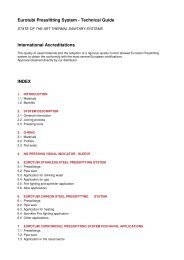corrosion of stainless steel - Damstahl
corrosion of stainless steel - Damstahl
corrosion of stainless steel - Damstahl
Create successful ePaper yourself
Turn your PDF publications into a flip-book with our unique Google optimized e-Paper software.
Chapter 6 - Corrosion <strong>of</strong> Stainless Steel<br />
Figure 6.5:<br />
General <strong>corrosion</strong> in <strong>stainless</strong> <strong>steel</strong> shackle (4301) after a long period in<br />
a nitric acid/hydr<strong>of</strong>luorid acid-based pickling bath. Note that the whole<br />
item is corroded, but that the end surfaces <strong>of</strong> the <strong>steel</strong> bar and welds have<br />
been slightly more aggressively attacked than the rest.<br />
Strong bases<br />
are rarely a<br />
problem in<br />
austenitic <strong>steel</strong><br />
6.1.4 General Corrosion in Alkaline Media<br />
In most cases, general <strong>corrosion</strong> is something that takes place in strong<br />
acids while it may come as a surprise for many that it may also take place in<br />
alkaline media. In the strong alkaline media, in particular, many metal salts<br />
(incl. oxides) are dissolved as complex ions, and this dissolution <strong>of</strong> course<br />
affects the passive layer negatively. This effect is <strong>of</strong>ten seen with metals such<br />
as aluminium and zinc which both corrode aggressively in a strong base, but<br />
even <strong>stainless</strong> <strong>steel</strong> can corrode at an extremely high pH.<br />
Along with the acidic conditions, extreme bases cause a homogenous<br />
thinning <strong>of</strong> the oxide layer and subsequent <strong>corrosion</strong> <strong>of</strong> the <strong>stainless</strong> <strong>steel</strong><br />
itself. Luckily, this weak, general <strong>corrosion</strong> is rarely something that affects<br />
the life <strong>of</strong> the <strong>steel</strong> to any significant degree. Even at 30% sodium hydroxide,<br />
NaOH, at 100°C the <strong>corrosion</strong> loss for both 4301 and 4401 will be approx.<br />
0.1 mm/year, while the loss under gentler conditions and particularly at<br />
lower temperatures will be much less. Ferritic <strong>stainless</strong> <strong>steel</strong> is generally<br />
more sensitive to general <strong>corrosion</strong> in alkaline media than austenitic.<br />
81<br />
RS for alle.indb 81<br />
9/29/2011 12:44:34 PM

















